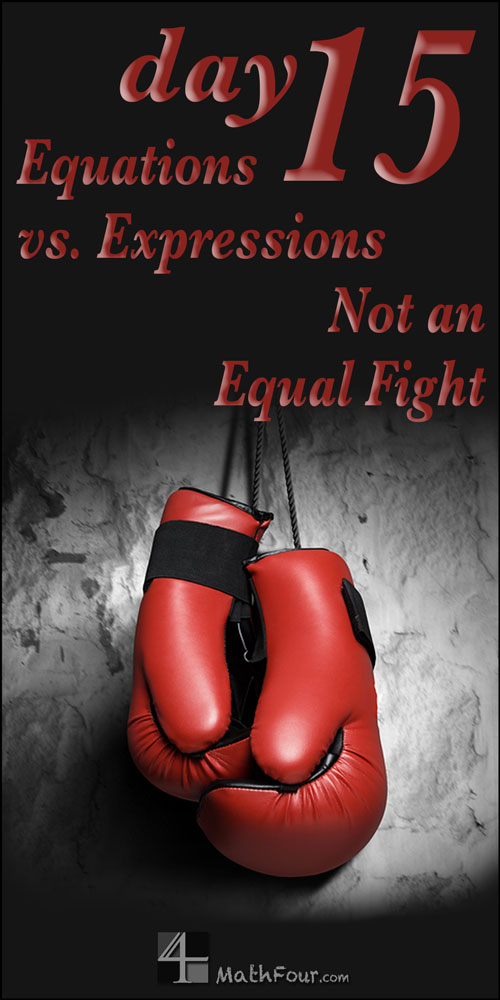This is Day 15 of 31 Days of Math Learning Success. Follow all the days here and check out others that are writing for 31 days here.

“I don’t trust equations. I trust quotes.”
~Khalid Masood
You’ve probably heard (or even said), “Whatever you do to one side, you have to do to the other.”
How about this one: “Set it equal to zero.”
Or maybe, “Plug it in.”
These phrases are all applicable to specific things – not generic terms that can be used in any math situation.
And the big differentiator is equation vs. expression.
Like Night and Day
You can separate your world into night and day. There’s a slight bit of iffy-ness when it comes to dawn and dusk, but generally night and day works.
Equations and expressions are like night and day. If you start with the equations, you’re most likely going to continue with the equations. Whereas if you start with expressions, generally you won’t create equations.
And just like dawn and dusk, there is a little bit of overlap.
Some Definitions
An expression is a collection of symbols. We’re most comfortable with expressions and make some sort of sense. For example, $latex 3+2$ is an expression. So is $latex 99((($, but that’s a little freakish looking.
An equation is an expression with an equal sign. More specifically, an equal sign that actually means two things are equivalent. (You can certainly have $latex 99===((($, but that doesn’t mean much right now. So we’d still call that an expression.)
You may have noticed that all equations are expressions. Much like all squares are rectangles. But like squares and rectangles, we mostly call expressions that are equations just equations. And we leave the word “expression” for non-equations.
Both Sides
The “sides” are the two sides of an equal sign. So that rule doesn’t apply to expressions. Like these:
$latex 42 = 97-55$
left hand side is $latex 42$, right hand side is $latex 97-55$
$latex y+3=19$
left hand side is $latex y+3$, right hand side is $latex 19$.
$latex 8x+3$
no sides (there are terms but not sides… see?)
Set it Equal to Zero
This only works if you turn an expression into an equation (like to graph it). And then it only works when you’re looking for the x-intercepts.
Me: Check out this expression: $latex 8x+3$
You: Gee, it sure would be swell to see a picture of that.
Me: Okay, graph $latex y = 8x + 3$
You: If I solve $latex 0 = 8x + 3$, I’ll get the x-intercept.
Me: Fo shizzle! (hashtag-I-wish-I-was-cool)
Just Plug It In
You can plug random things into the variables in an equation, but it may not make it true.
Me: Check out this equation: $latex y+3=19$
You: Let’s plug in my favorite number $latex 7$ for $latex y$.
Me: No prob, but that gives us $latex 10=19$
You: Which means you owe me an ice cream.
Me: Whatever.
But if you plug them into an expression, there’s no truth to it. It just gives out a number. And that’s okay.
Me: Check out this expression: $latex 8x+3$
You: Hey, cram my favorite number $latex 7$ in for $latex x$.
Me: Okay, that gives $latex 59$.
You: Groovy. Let’s go get ice cream. I’ll buy.
Are you enjoying the 31 Days of Math Learning Success? Share it on Twitter, Facebook and Pinterest!
This post may contain affiliate links. When you use them, you support us so we can continue to provide free content!








Sorry, comments are closed for this post.